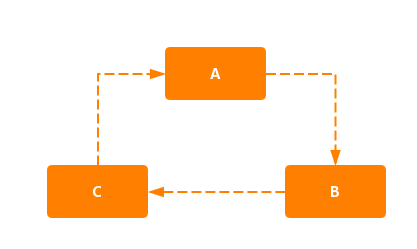您好,登錄后才能下訂單哦!
您好,登錄后才能下訂單哦!
這篇文章主要介紹Spring解決循環依賴的示例分析,文中介紹的非常詳細,具有一定的參考價值,感興趣的小伙伴們一定要看完!
這里我們先借用一張圖來通過視覺感受一下,看圖:

其實,通過上面圖片我想你應該能看圖說話了,所謂的循環依賴其實就是一種死循環。想象一下生活中的例子就是,你作為一個猛男喜歡一個蘿莉,而蘿莉卻愛上了你的基友娘炮,但是娘炮心理卻一直想著和你去澡堂洗澡時撿你扔的肥皂。
是的,這就是循環依賴的本因。當spring啟動在解析配置創建bean的過程中。首先在初始化A的時候發現需要引用B,然后去初始化B的時候又發現引用了C,然后又去初始化C卻發現一個操蛋的結果,C引用了A。它又去初始化A一次循環無窮盡,如你們這該死的變態三角關系一樣。
既然形成了這種看起來無法 解決的三角關系,那么有什么辦法解決呢?相信聰明的你在面對這樣尷尬的境地,已經開始思考解決方案了。想不想的出來沒關系,我們看看spring的大神們是如何來解決這個問題的。
Spring解決循環依賴的方法就是如題所述的三級緩存、預曝光。
Spring的三級緩存主要是singletonObjects、earlySingletonObjects、singletonFactories這三個Map:
代碼 1-1:
/** Cache of singleton objects: bean name --> bean instance */ private final Map<String, Object> singletonObjects = new ConcurrentHashMap<>(256); /** Cache of singleton factories: bean name --> ObjectFactory */ private final Map<String, ObjectFactory<?>> singletonFactories = new HashMap<>(16); /** Cache of early singleton objects: bean name --> bean instance */ private final Map<String, Object> earlySingletonObjects = new HashMap<>(16);
我們知道了Spring為解決循環依賴所定義的三級緩存了,那么我們就來看看它是如何通過這三級緩存來解決這個問題的。
代碼 1-2:
@Nullable
protected Object getSingleton(String beanName, boolean allowEarlyReference) {
Object singletonObject = this.singletonObjects.get(beanName); //首先通過beanName從一級緩存獲取bean
if (singletonObject == null && isSingletonCurrentlyInCreation(beanName)) { //如果一級緩存中沒有,并且beanName映射的bean正在創建中
synchronized (this.singletonObjects) {
singletonObject = this.earlySingletonObjects.get(beanName); //從二級緩存中獲取
if (singletonObject == null && allowEarlyReference) { //二級緩存也沒有
ObjectFactory<?> singletonFactory = this.singletonFactories.get(beanName); //從三級緩存獲取
if (singletonFactory != null) {
singletonObject = singletonFactory.getObject(); //獲取到bean
this.earlySingletonObjects.put(beanName, singletonObject); //將獲取的bean提升至二級緩存
this.singletonFactories.remove(beanName); //從三級緩存刪除
}
}
}
}
return singletonObject;
}上面的方法就是Spring獲取single bean的過程,其中的一些方法的解釋我就直接借用其它博主的文摘了:
isSingletonCurrentlyInCreation():判斷當前 singleton bean 是否處于創建中。bean 處于創建中也就是說 bean 在初始化但是沒有完成初始化,有一個這樣的過程其實和 Spring 解決 bean 循環依賴的理念相輔相成,因為 Spring 解決 singleton bean 的核心就在于提前曝光 bean。
allowEarlyReference:從字面意思上面理解就是允許提前拿到引用。其實真正的意思是是否允許從 singletonFactories 緩存中通過getObject()拿到對象,為什么會有這樣一個字段呢?原因就在于 singletonFactories 才是 Spring 解決 singleton bean 的訣竅所在。
好了,說道這里我們來縷清一下當我們執行下面代碼獲取一個name為 user 的bean時Spring都經過了怎樣的過程。
代碼 1-3:
ClassPathResource resource = new ClassPathResource("bean.xml");
DefaultListableBeanFactory factory = new DefaultListableBeanFactory();
XmlBeanDefinitionReader reader = new XmlBeanDefinitionReader(factory);
reader.loadBeanDefinitions(resource);
UserBean user = (UserBean) factory.getBean("user");通過追蹤源碼我們發現getBean()方法執行后會調用到AbstractBeanFactory.doGetBean()方法,在此方法中調用了我們上文提到的關鍵getSingleton()。因為開始啟動項目,獲取第一個bean時緩存都是空的,所以直接返回一個null。追蹤源碼發現,在doGetBean()后面會調用到AbstractAutowireCapableBeanFactory.doCreateBean()方法進行bean創建,詳細流程就自行追蹤源碼。在這個方法中有一段代碼:
代碼 1-4:
// Eagerly cache singletons to be able to resolve circular references
// even when triggered by lifecycle interfaces like BeanFactoryAware.
boolean earlySingletonExposure = (mbd.isSingleton() && this.allowCircularReferences &&
isSingletonCurrentlyInCreation(beanName)); //通過條件判斷該bean是否允許提前曝露
if (earlySingletonExposure) {
if (logger.isTraceEnabled()) {
logger.trace("Eagerly caching bean '" + beanName +
"' to allow for resolving potential circular references");
}
addSingletonFactory(beanName, () -> getEarlyBeanReference(beanName, mbd, bean)); //允許提前暴露的bean 添加到三級緩存
}通過上面的代碼我們發現,可以提前暴露的bean通過addSingletonFactory()方法添加到了三級緩存SingletonFactories 中,我們看一下它是怎樣操作的。
代碼 1-5:
protected void addSingletonFactory(String beanName, ObjectFactory<?> singletonFactory) {
Assert.notNull(singletonFactory, "Singleton factory must not be null");
synchronized (this.singletonObjects) {
if (!this.singletonObjects.containsKey(beanName)) {
this.singletonFactories.put(beanName, singletonFactory); //添加到三級緩存
this.earlySingletonObjects.remove(beanName);
this.registeredSingletons.add(beanName);
}
}
}此時,我們的user這個bean就被加入到了三級緩存中,那么什么樣bean的才會被加入到三級緩存中呢?就是代碼 1-4中的三個判斷條件:
單例
允許循環引用的bean
當前 bean 正在創建中
到這里user這個bean已經創建,但是它還不是一個完整的bean,還需要后續的初始化。但是這不影響其它的bean引用它,假設user為開始圖中的A,那么當在初始化A(user)的時候,發現A中有一個屬性B,在調用方法applyPropertyValues()去設置這個B的時候。會發現B還沒創建,Spring就會在重復創建A的流程調用doCreate()來創建B,然后添加到三級緩存,設置B的屬性C時,發現C也還沒創建,接著重復前述doCreate()步驟進行C的創建。C創建完成,進行初始化發現C引用了A,這時關鍵的地方就是上面的代碼1-2處。
在C設置屬性A的時候,調用getSingleton()獲取bean時,因為A已經在代碼1-4處添加到了三級緩存中,C可以直接獲取到A的實例并設置成功后,繼續完成自己創建。初始化完成后,調用如下方法將自己添加到一級緩存。
代碼 1-6:
protected void addSingleton(String beanName, Object singletonObject) {
synchronized (this.singletonObjects) {
this.singletonObjects.put(beanName, singletonObject);
this.singletonFactories.remove(beanName);
this.earlySingletonObjects.remove(beanName);
this.registeredSingletons.add(beanName);
}
}以上是“Spring解決循環依賴的示例分析”這篇文章的所有內容,感謝各位的閱讀!希望分享的內容對大家有幫助,更多相關知識,歡迎關注億速云行業資訊頻道!
免責聲明:本站發布的內容(圖片、視頻和文字)以原創、轉載和分享為主,文章觀點不代表本網站立場,如果涉及侵權請聯系站長郵箱:is@yisu.com進行舉報,并提供相關證據,一經查實,將立刻刪除涉嫌侵權內容。